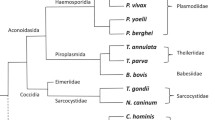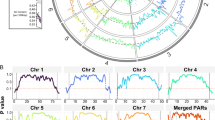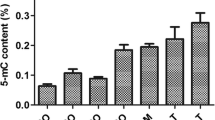Abstract
We report the analysis of the biases of CpG, TpG, and CpA of all the DNA sequences data from the Trematode Schistosoma mansoni. Our results show CpG avoidance whereas TpG and CpA frequencies are over the expected values. These characteristics are similar to the biases displayed by methylated genomes, but in platyhelminths 5mC has not been detected by biochemical methods. The possible implications of this CpG shortage are discussed.
Similar content being viewed by others
References
Aïsani B, Bernardi G (1991) CpG islands: features and distribution in the genomes of vertebrates. Gene 106:173–183
Antequera F, Bird AP (1988) Unmethylated CpG islands associated with genes in higher plant DNA. EMBO J 7:2295–2299
Bernardi G, Olofsson B, Filipski J, Zerial M, Salinas J, Cuny G, Mugnier-Rotival M, Rodier F (1985) The mosaic genome of warm blooded vertebrates. Science 228:953–958
Bird AP (1980) DNA methylation and the frequency of CpG in animal DNA. Nucleic Acids Res 8:1499–1504
Bird AP (1983) DNA modification. In: Maclean N, Gregory SP, Flavell RA (eds) Eukaryotic genes, their structure, activity and regulation. Butterworth & Co, London, pp 53–67
Bird AP (1986) CpG-rich islands and the function of DNA methylation. Nature 321:209–213
Cox GS, Phares CK, Schmidt RA (1990) Molecular characterization of the Spirometra mansonoides genome: renaturation kinetics, methylation, and hybridization to human cDNA probes. Biochem Biophys Acta 1049:134–144
Drouin G (1991) Non random CpG mutations affect the synonymous codon usage of moderately GC-rich single copy actin genes. J Mol Evol 33:237–240
Ehrilch M, Gama-Sosa MA, Huang L-H, Midgett RM, Kuo KC, McCune RA, Gehrke C (1982) Amount and distribution of 5-methylcytosine in human DNA from different types of tissues or cells. Nucleic Acids Res 10:2709–2721
Gouy M, Milleret F, Mugnier C, Jacobzone M, Gautier C (1984) ACNUC: a nucleic acid sequence data base and analysis system. Nucleic Acids Res 12:121–127
Green PM, Montandon AJ, Bentley DR, Ljung R, Nilsson IM, Gianelli F (1990) The incidence and distribution of CpG → TpG transitions in the coagulation factor IX gene. A fresh look at CpG mutational hotspots. Nucleic Acids Res 18:3227–3231
Hanai R, Wada A (1988) The effects of guanine and cytosine variation on dinucleotide frequency and amino acid composition in the human genome. J Mol Evol 27:321–325
Hanai R, Wada A (1990) Doublet preference and gene evolution. J Mol Evol 30:109–115
Johnson AM (1990) Comparison of dinucleotide frequency and codon usage in Toxoplasma and Plasmodium: evolutionary implications. J Mol Evol 30:383–387
Josse J, Kaiser AA, Kornberg A (1961) Enzymatic synthesis of deoxyribonucleic acid VIII. Frequencies of nearest neighbour base sequences in deoxyribonucleic acid. J Biol Chem 236:864–875
McClelland M, Ivarie R (1982) Asymmetrical distribution of CpG in an ‘average’ mammalian gene. Nucleic Acids Res 10:7855–7877
Montero LM, Salinas J, Matassi G, Bernardi G (1990) Gene distribution and isochore organization in the nuclear genome of plants. Nucleic Acids Res 18:1859–1867
Nussinov R (1984) Doublet frequencies in evolutionary distinct groups. Nucleic Acids Res 12:1749–1763
Ohno S (1988) Universal rule for coding sequence construction: TA/CG deficiency-TG/CT excess. Proc Natl Acad Sci USA 85:9630–9634
Salser W (1977) Globin mRNA sequences: analysis of base pairing and evolutionary implications. Cold Spring Harbor Symp Quant Biol 40:985–1002
Savatier P, Trabuchet G, Faure C, Chebloune Y, Gouy M, Verdier G, Nigon VM (1985) Evolution of the primate beta-globin gene region. High rate of variation in CpG dinucleotides and in short repeated sequences between man and chimpanzee. J Mol Biol 182:21–29
Simpson A, Sher A, McCutchan T (1982) The genome of Schistosoma mansoni: isolation of DNA, its size, bases and repetitive sequences. Mol Biochem Parasitol 6:125–137
Swartz MN, Trautner TA, Kornberg A (1962) Enzymatic syntheses of deoxyribonucleic acid XI. Further studies on nearest neighbor base sequences in deoxyribonucleic acids. J Biol Chem 237:1961–1967
Yomo T, Ohno S (1989) Concordant evolution of coding and noncoding regions of DNA made possible by the universal rule of TA/CG deficiency-TG/CT excess. Proc Natl Acad Sci USA 86:8452–8456
Author information
Authors and Affiliations
Rights and permissions
About this article
Cite this article
Musto, H., Rodríguez-Maseda, H., Alvarez, F. et al. Possible implications of CpG avoidance in the flatworm Schistosoma mansoni . J Mol Evol 38, 36–40 (1994). https://doi.org/10.1007/BF00175493
Received:
Accepted:
Issue Date:
DOI: https://doi.org/10.1007/BF00175493




